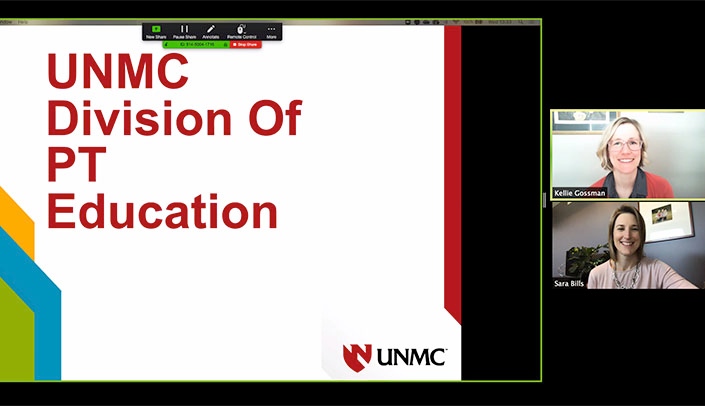When learning abruptly moved off campus, thanks to the ongoing COVID-19 pandemic, UNMC educators and students had to adapt — and quickly. Jeffrey P. Gold, M.D., called it a time of “unprecedented transition.”
At the physical therapy education program, in the College of Allied Health Professions, “We are handling this transition well thanks to a pre-established culture of collaboration, which was established far before COVID-19,” said Sara Bills, D.P.T., who with Kellie Gossman, D.P.T., moved rapidly to transition curriculum to remote education. “Individuals like Dr. Pat Hageman and Dr. Joe Norman, both former program directors and still on faculty, have shown us how to leverage team members’ strengths and build cohesion. Our current director, Dr. Betsy Becker, has been a rock.”
The College of Medicine, to offset lost clinical training hours, created a new eight-week COVID-19 course from scratch. Well, not quite from scratch, said Regan Taylor, M.D.: “Often, the content you need has been created somewhere — look for it, and don’t try to reinvent the wheel!”
Ally Dering-Anderson, Pharm.D., isn’t afraid to admit she sometimes feels less than confident in the new normal. Yet, she looked for a solution, and soldiered on: “I get super flustered when technology fails and I take it personally,” she said. “So, I have all of my lectures done on ECHO captured videos.”
Amber Donnelly, Ph.D., professor and director of the UNMC Cytotechnology Program, in the College of Allied Health Professions, is teaching virtual microscopy from home. Cytotechnology had a head start on its COVID-19 planning, as Dr. Donnelly and collaborator Manju Mukherjee, Ph.D., already conduct the nation’s only virtual microscopy program, teaching students remotely across the U.S.
At the College of Pharmacy, pharmacotherapy labs previously were heavy on significant amount of face-to-face group work to solve clinical cases, as well as face-to-face simulated patient interviews, mock inpatient rounds presentations, prescription processing and order verification, medication reconciliation, and over the counter patient consults.
“The Zoom Breakout Rooms feature has been a valuable tool to achieve some of these simulated clinical encounters virtually,” saidd Kristen Cook, Pharm.D. Through this feature, “We were able to still provide an interaction that evaluated their communication with other health care providers, and gave them one-on-one feedback without having anyone be in the same physical space.”
Shayla Yoachim, Ph.D., assistant professor in the College of Dentistry, offered four important tips: be consistent, connect early and often (using a variety of mechanisms), explore new tools, and be realistic about expectations, both for students and yourself.
“No one signed up for this,” Dr. Yoachim said. “This is a product of our situation, and we’re all trying our best to make it as painless as possible.
“Showing respect for our students, empathizing with them, revealing our own obstacles, emphasizing our dedication to their success, and connecting with them even if just virtually, reminds them that we are in this together and that we are in the for the long-haul — together.”
Said Beth Culross, Ph.D., assistant professor of the College of Nursing: “I think the most important thing we have learned is that the faculty have amazing and creative ideas to continue to help our students meet the objectives and outcomes of the program.”
Some other quick tips:
- “One of the things I would highlight is the diligence that Dean Olsen and Associate Deans Klepser and Shaffer have shown in keeping students informed. We don’t have ‘all the answers.’ No one does, but we also don’t have any secrets from our students. They are hanging in there with us.” -Dr. Dering-Anderson
- “One thing that’s been helpful in my course . . . is frequent quizzing rather than large unit exams. It has given more opportunity for regular checkpoints with the students, breaks content into more manageable chunks, and adds more structure to an online unit.” -Annie Wildermuth, assistant professor and associate program director, physician assistant education
- “(While planning) we decided to have daily drop-in sessions, called COVID Collaborations, to help each other brainstorm solutions to common challenges . . . Some faculty dropped in with problems, others dropped in to provide possible solutions.” -Drs. Gossman and Bills
- The College of Public Health has created an entire online guide to pivoting to teaching online. It includes information on converting your campus course content, as well as tutorial videos for Canvas, VidGrid and Zoom.
- Zoom has been used for proctoring in testing under distance conditions, Dr. Culross said.
